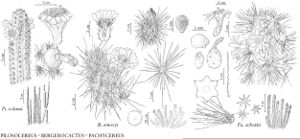Pachycereus
Contr. U.S. Natl. Herb. 12: 420. 1909.
| Taxon | Illustrator ⠉ | |
|---|---|---|
 | Pilosocereus robinii Bergerocactus emoryi Pachycereus schottii | John Myers John Myers John Myers |
Shrubs [trees], erect, branched, branches mostly basal, closely parallel [to candelabra-shaped or solitary]. Roots diffuse. Stems unsegmented, dark green or green to blue-green or glaucous gray-green, thick columnar, often somewhat narrowed between growth increments, 300–4500 [–700] × [5–] 12–16 [–100 in P. weberi] cm, sometimes dimorphic with terminal reproductive zone or cephalium bearing specialized, densely spiny areoles; ribs [absent on cephalium in P. militaris or 3–] 4–7 [–16 in P. pringlei], nearly triangular in cross-section to rounded, rib crests flat to crenate; areoles distinct or confluent via felty abaxial grooves along ribs, of [1 or] 2 kinds, circular to shield-shaped and slightly raised to elongate and flat; hairs white to light gray; areolar glands absent; cortex and pith not mucilaginous, blackening when cut, firm, pith often exceeding 5 cm diam. Spines [0–] 5–20 [–60] per areole, whitish gray to gray, sometimes aging black; radial spines on proximal, nonflower-producing portions of stems, acicular to short and stout, usually less than 3 cm; central spines (0–) 1 (–3) per areole, usually pointing toward stem base, otherwise longer but similar to radial spines in form and color, (1–) 3 (–10+ in P. weberi) cm; on flowering areoles radial and central spines not readily distinguishable, bristles numerous [or nearly absent], gray [amber-yellow to golden or reddish-brown], wiry, long, slender. Flowers nocturnal [or diurnal], several per areole [or solitary], subterminal to lateral on distal 1–3 m of stem in cephalium of specialized, densely bristly, nearly confluent areoles [or stem areoles not specialized], from adaxial portion of areoles, cylindric to narrowly funnelform, narrowly campanulate, or short funnelform, 3–4.5 [–12] cm; tepals spreading [to ascending or erect], margins entire to fimbriate; outer tepals with pink to rose centers and lighter margins [to yellowish, greenish, or rose-maroon]; inner tepals whitish pink [to ivory white, yellowish, rose, or coral]; ovary few scaled [to very scaly], spineless [to very spiny or bristly]; scales soon deciduous [persistent], rose-red to yellowish, soon turning black [or not changing], triangular with prominent bases, fleshy [to papery], tips acute to acuminate, with axillary tufts of whitish to tan hairs [to densely tan woolly]. Fruits indehiscent [to irregularly dehiscent or dehiscing by vertical slits], reddish [sometimes color hidden by tan to yellowish wool], ovoid to spheric, 20–75 mm diam.; areoles ± absent [or deciduous or persistent], spineless [or spiny to densely covered with wirelike bristles]; pulp slightly sour to sweet, colorless or wine red [purplish or yellowish], often not filling locule; floral remnant absent [or persistent]. Seeds black, ovoid to helmet or comma-shaped, 2.2–2.8 [–6] mm, glossy; testa relatively smooth [to ± papillate], cells usually flat with minute pits at “corners” between cells. x = 11.
Distribution
s Ariz., Mexico, Central America
Discussion
Species 8 (1 in the flora).
When A. Berger proposed Cereus subgenus Pachycereus, he had in mind a lineage of gigantic columnar species with very thick stems. In their subsequent revision of Pachycereus as a genus N. L. Britton and J. N. Rose (1919–1923, vol. 2) recognized ten Mexican species including P. pringlei as the type. Of those ten, only three species, P. pringlei (S. Watson) Britton & Rose, P. grandis Rose, and P. pecten-aboriginum (Engelmann ex S. Watson) Britton & Rose remain at the core of the genus in all subsequent treatments (e.g., F. Shreve and I. L. Wiggins 1964), whereas other species have been added and removed by various authors.
In their phylogenetic studies of columnar cacti, A. C. Gibson and K. E. Horak (1978) concluded that Pachycereus, in the strict sense, belongs to a lineage of Mexican cacti having succulent stem tissues that blacken rapidly after being cut and possess unusual tetrahydroisoquinoline alkaloids. Using the data summarized by Gibson and Horak, the International Cactaceae Systematics Group (D. R. Hunt and N. P. Taylor 1986, 1990; E. A. Anderson 2001) broadened the definition of Pachycereus to include Lophocereus, Backebergia, Marginatocereus, Pterocereus MacDougall & Miranda, Lemaireocereus hollianus (F. A. C. Weber) Britton & Rose, Anisocereus lepidanthus (Eichlam) Backeberg, and Mitrocereus fulviceps (F. A. C. Weber ex Schumann) Backeberg, while excluding Carnegiea gigantea, and acknowledging that several species are either poorly known or enigmatic. Although flowers and fruits of Lophocereus species are naked, the shoots in that genus are very similar chemically, morphologically, and anatomically to P. marginatus (de Candolle) Britton & Rose and Backebergia militaris (Audot) Bravo ex Sánchez-Mejorada. Subsequent sequence analysis of chloroplast DNA has also confirmed that “Lophocereus” schottii and P. marginatus are extremely closely related (J. H. Cota and R. S. Wallace 1996).
Most recently, E. F. Anderson (2001) defined Pachycereus to include several species for which the evidence for inclusion is either lacking or contradictory. The conservative treatment of Pachycereus followed here limits its composition to eight species and reserves judgment on others until rigorous DNA analyses of all suspect taxa, including several species of Lemaireocereus Britton and Rose, are completed.